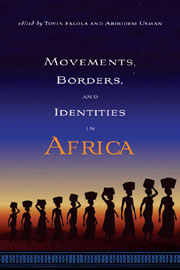Introduction: Migrations in African History: An Introduction
Published online by Cambridge University Press: 12 September 2012
Summary
Migration has become a continuous phenomenon in the history of human societies. Migration is synonymous with the history of Africa itself. The migration of individuals and groups over time is associated with the emergence of cultures and of civilizations throughout the world. This book establishes the centrality of migrations and movements of people in the historical evolution of African peoples and societies. By making use of different sources—oral, archaeological, and written—and focusing on various subjects and geographical areas, the book shows that migration was a multifaceted phenomenon, which varied in nature and character, over time and in different places. Using carefully selected case studies drawn from across the continent, the book provides a broad but insightful overview of the subject of migrations, and the varying impact of slavery, commerce, gender, religion, colonialism, poverty, and development on the movements of people and ideas, and on the development of states and societies on the continent, most especially in the last two centuries.
There are two forms of migration patterns in Africa. These are internal and international migrations. Internal migrations are migrations within countries, while international migrations are movements between countries. The most common form of international migration in the past was the forced migration of the slave trade, conducted by Arab and European traders. Internal migration consists of rural-urban mobility, rural-rural mobility, urban-rural mobility, and urban-urban mobility. The poorly defined boundaries between nations, the complementary nature of the economies of neighboring countries, and the cultural relationship between ethnic groups in various countries obscure the differences between internal and international migration in Africa.
- Type
- Chapter
- Information
- Movements, Borders, and Identities in Africa , pp. 1 - 34Publisher: Boydell & BrewerPrint publication year: 2009



